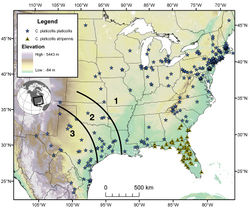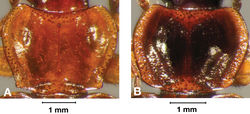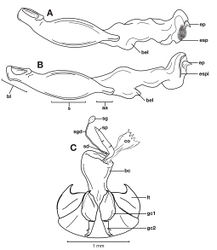Cymindis platicollis atripennis
| Notice: | This page is derived from the original publication listed below, whose author(s) should always be credited. Further contributors may edit and improve the content of this page and, consequently, need to be credited as well (see page history). Any assessment of factual correctness requires a careful review of the original article as well as of subsequent contributions.
If you are uncertain whether your planned contribution is correct or not, we suggest that you use the associated discussion page instead of editing the page directly. This page should be cited as follows (rationale):
Citation formats to copy and paste
BibTeX: @article{Hunting2013ZooKeys259, RIS/ Endnote: TY - JOUR Wikipedia/ Citizendium: <ref name="Hunting2013ZooKeys259">{{Citation See also the citation download page at the journal. |
Ordo: Coleoptera
Familia: Carabidae
Genus: Cymindis
Name
Cymindis platicollis (Casey) stat. n. – Wikispecies link – Pensoft Profile
- Pinacodera atripennis Casey 1920[1]: 284. HOLOTYPE male labeled: “Fla; Casey bequest 1925”; “TYPE 47613” [red paper]; “atripennis Csy” [handwritten]. TYPE AREA – Florida, U.S.A. – Kirk 1970[2]: 17. Ciegler 2000[3]: 119. comb. n.
- Cymindis atripennis; Poole and Gentili 1996[4]: 103. [from Ciegler 2000[3]].
Diagnosis
Specimens of this subspecies have a rufous to rufo-brunneous head and pronotum coloration that contrasts strikingly with the darker, brunneo-piceous to rufo-piceous elytral coloration (Fig. 16).
Description
With character states of subgenus Pinacodera and species Cymindis platicollis restricted as follows: OBL 8.17 – 10.83 mm. Length (n= 10 males, 10 females): head 0.74 – 1.02, pronotum 1.52 – 2.08, elytra 4.92 – 6.42, metepisternum 1.08 – 1.58 mm; width: head 1.64 – 2.04, pronotum 2.08 – 2.72, elytra 3.33 – 4.33, metepisternum 0.58 – 0.84 mm.
Body proportions. HW/HL 1.86 – 2.24; PWM/PL 1.30 – 1.40; EL/EW 1.40- 1.52; ML/MW1.71 – 2.41.
Color. Dorsum of head and pronotum rufous to rufo-brunneous; antennae rufo-brunneous to brunneous; palpi rufo-brunneous to brunneous; elytra brunneo-piceous to rufo-piceous with pale, somewhat translucent margins, elytral epipleura testaceous to rufo-testaceous; thoracic sclerites and abdominal sterna testaceous to rufo-piceous.
Microsculpture. Microlines not visible on dorsum of head capsule and pronotum at 50× magnification. Elytra with mesh pattern isodiametric, microlines clearly defined throughout.
Macrosculpture and pilosity. Head capsule, dorsal surface with shallow, randomly scattered setigerous punctures on dorsal surface from constriction of neck extended anteriorly toward clypeus. Elytra with striae moderately impressed and punctulate throughout length; intervals 2, 4, 6 and 8 typically with two to three rows of scattered punctures; all other intervals with one row of punctures.
Metepisternum. Distinctly longer than wide.
Hind wings. Macropterous.
Male genitalia. Phallus (Fig. 20A) length 1.70 – 2.00 mm.
Collection notes and habitat
The known elevational range of Cymindis platicollis atripennis extends from sea level to 90 m. Specimens were collected on forest floor, under and on bark of trees and associated mosses in forests of cypress, juniper, magnolia, several oak species and both slash and loblolly pine. This subspecies has been collected from sand dunes in close proximity to water as well as from squirrel and caracara nests in trees. Methods of collecting include: dusk-dawn suction traps, medfly traps, u.v. and light traps, FIT’s, sugaring baits painted on tree trunks, beating vegetation, hand collecting, Steiner traps, pitfall traps, and sticky traps.
Geographical distribution
The range of this subspecies extends from southern Florida north to mid-Georgia and west to southern Mississippi (Fig. 17).
Morphological affinities
This subspecies is, by definition, the closest relative of Cymindis platicollis platicollis.
Chorological affinities
Cymindis platicollis atripennis is sympatric in portions of its range with Cymindis limbata, Cymindis complanata and Cymindis rufostigma. It is allopatric with Cymindis platicollis platicollis and all other species in the limbata group.
Material examined
I examined 227 specimens; 13 males and 11 females were dissected. For details see University of Alberta Strickland Virtual Entomology Museum Database (University of Alberta 2009[5]).
Taxon Treatment
- Hunting, W; 2013: A taxonomic revision of the Cymindis (Pinacodera) limbata species group (Coleoptera, Carabidae, Lebiini), including description of a new species from Florida, U.S.A. ZooKeys, 259: 1-73. doi
Other References
- ↑ Casey T (1920) Random studies among the American Caraboidea. In: Casey TL, Memoirs on the Coleoptera, Vol IX. New Era Publishing Company, Lancaster, Pennsylvania, 133–299.
- ↑ Kirk V (1970) A list of the beetles of South Carolina. Part 2—mountain, piedmont, and southern coastal plain. South Carolina Agricultural Experiment Station Technical Bulletin 1038: 1-117.
- ↑ 3.0 3.1 Ciegler J (2000) Ground beetles and wrinkled bark beetles of South Carolina (Coleoptera: Geadephaga: Carabidae and Rhysodidae). South Carolina Agriculture and Forestry Research System, Clemson University, 149.
- ↑ Poole R, Gentili, P (Eds) (1996) Nomina Insecta Nearctica, a checklist of the insects of North America. Volume 1. Coleoptera, Strepsiptera. Entomological Information Services, Rockville, Maryland, 827 pp.
- ↑ University of Alberta (2009) E. H. Strickland Virtual Entomology museum Database. Retrieved August 25, 2009, Web site: http://www.entomology.museums.ualberta.ca/
Images
|



